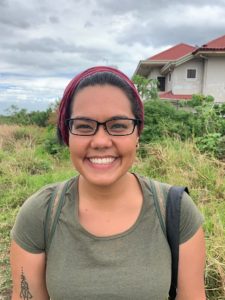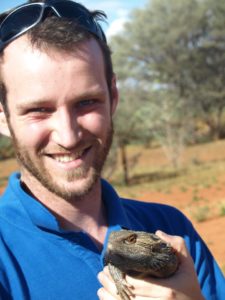A Griffith University student has played a key role in the discovery and description of a new gecko species — the eye-catching yellow-snouted bent-toed gecko from a mountain forest in Papua New Guinea.

Denise Karkkainen.
Denise Karkkainen, a Bachelor of Science in Ecology and Conservation Biology graduate, was hand-picked by lecturer Dr Paul Oliver, who is also a member of Griffith’s Environmental Futures Research Institute and a Queensland Museum curator, to collaborate on describing the colourful new species Cyrtodactylus manus.
The sole specimen is a female, collected back in 2001, but with no additional specimens forthcoming Dr Oliver enlisted the help of Karkkainen in describing it in Queensland Museum’s labs for this latest study, published in the journal Zootaxa.
Comparatively small for the Cyrtodactylus genus at just 73mm, this new species was also distinguished by its distinctive colouration and body and tail scalation.
The yellow-snouted bent-toed gecko adds to the growing number of vertebrate species known only from the limestone mountains along the southern edge of New Guinea’s Central Cordillera.
“Dr Oliver offered the opportunity to work with him at Queensland Museum and collaborate on describing a new gecko species, which was mind blowing in itself,” Karkkainen said.
“I was fortunate enough to have a great learning experience such as this one where I was able to have guidance and someone to ask my many questions.
“Throughout the duration of my degree, we learnt about evolution and speciation theoretically, as well as practical skills to identify and distinguish described species from one another.
“However, personally, it wasn’t until I gained first-hand experience that I was able to grasp a better understanding of the process involved in describing a new species and documenting biodiversity.”
Dr Oliver said New Guinea remains a frontier for biodiversity discovery.
“As far as we know, the male still hasn’t been documented or collected by a scientist,” he said.
“This is a pretty common story, indeed, as many as seventh of all lizard species are only know from a single place.

Dr Paul Oliver.
“We don’t believe this new gecko is endangered, because they’re found very high up in a karst mountain range, so local people don’t go up there much. There are large areas of undisturbed habitat that is very hard to access and survey.
“Getting students involved in the process of documenting biodiversity is a great opportunity. There so much left to do, so we need to get the next generation of scientists involved in the process.”
Dr Oliver said there is amazing research that takes place in Queensland Museum, and Griffith University had a fantastic relationship that enabled students like Karkkainen to participate in these types of discoveries.
“This was a great experience to do while still doing my undergrad. It gave me solid skills that I can take forward into the future,” Karkkainen said.
“Go out and volunteer on research projects as much as you can. They are great opportunities to develop and gain useful skills and experience.
“Also, you never know what other opportunities may arise from them — like describing a new species and contributing to a paper.”
